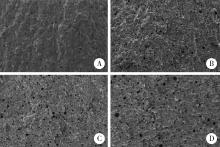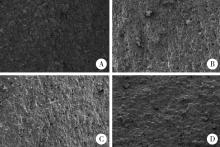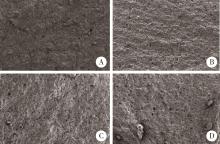Journal of Peking University (Health Sciences) ›› 2023, Vol. 55 ›› Issue (1): 78-81. doi: 10.19723/j.issn.1671-167X.2023.01.011
Previous Articles Next Articles
Influence of paper mixing pads thickness on the compressive strength of glass ionomer cement
Qian-mei ZHOU1,Rui-yu DING2,Li LI1,Wei BAI3,Jing-ying HU1,*( )
)
- 1. Department of General Dentistry Ⅱ, Peking University School and Hospital of Stomatology & National Center of Stomatology & National Clinical Research Center for Oral Diseases & National Engineering Research Center of Oral Biomaterials and Digital Medical Devices & Beijing Key Laboratory of Digital Stomatology & NHC Research Center of Engineering and Technology for Computerized Dentistry & NMPA Key Laboratory for Dental Materials, Beijing 100081, China
2. Department of Geriatric Dentistry, Peking University School and Hospital of Stomatology & National Center of Stomatology & National Clinical Research Center for Oral Diseases & National Engineering Research Center of Oral Biomaterials and Digital Medical Devices & Beijing Key Laboratory of Digital Stomatology & NHC Research Center of Engineering and Technology for Computerized Dentistry & NMPA Key Laboratory for Dental Materials, Beijing 100081, China
3. Department of Dental Materials, Peking University School and Hospital of Stomatology & National Center of Stomatology & National Clinical Research Center for Oral Diseases & National Engineering Research Center of Oral Biomaterials and Digital Medical Devices & Beijing Key Laboratory of Digital Stomatology & NHC Research Center of Engineering and Technology for Computerized Dentistry & NMPA Key Laboratory for Dental Materials, Beijing 100081, China
CLC Number:
- R783.1
| 1 | Nicholson JW . Adhesive dental materials and their durability[J]. INT J Adhes, 2000, 20 (1): 11- 16. |
| 2 | Bayrak S , Tunc ES , Aksoy A , et al. Fluoride release and recharge from different materials used as fissure sealants[J]. Eur J Dent, 2010, 4 (3): 245- 250. |
| 3 | Fleming GCP , Farooq AA , Barralet JE . Influence of powder/liquid mixing ratio on the performance of a restorative glass-ionomer dental cement[J]. Biomaterials, 2003, 24 (23): 4173- 4179. |
| 4 | Sulaiman T , Abdulmajeed A , Altitinchi A , et al. Effect of resinmodified glass ionomer cement dispensing/mixing methods on mechanical properties[J]. J Oper Dent, 2018, 43 (4): 158- 165. |
| 5 | Singer L , Bierbaum G , Kehl K , et al. Evaluation of the antimicrobial activity and compressive strength of a dental cement modified using plant extract mixture[J]. J Mater Sci Mater Med, 2020, 31 (12): 116. |
| 6 | International Organization of Standardization. ISO 9917-1: 2007-dental-water-based cements. Part 1: Powder/liquid acid-base cements[S]. Geneva: ISO, 2016. |
| 7 | D'Alpino PH , Lopes LG , Pereira JC . Mechanical properties of dental restorative material: Relative contribution of laboratory test[J]. J Appl Oral Sci, 2003, 11 (3): 162- 167. |
| 8 | Dowling AH , Fleming GJP . Are encapsulated anterior glass-ionomer restoratives better than their hand-mixed equivalents[J]. J Dent, 2009, 37 (2): 133- 140. |
| 9 | Nomoto R , Komoriyama M , McCabe JF , et al. Effect of mixing method on the porosity of encapsulated glass ionomer cement[J]. Dent Mater, 2004, 20 (10): 972- 978. |
| 10 | Schulze KA , Zaman AA , Söderholm KJM , et al. Effect of filler fraction on strength, viscosity and porosity of experimental compomer materials[J]. J Dent, 2003, 31 (6): 373- 382. |
| 11 | Nomoto R , McCabe JF . Effect of mixing methods on the compressive strength of glass ionomer cements[J]. J Dent, 2001, 29 (3): 205- 210. |
| 12 | Kaushik M , Sharma R , Reddy P , et al. Comparative evaluation of voids present in conwentional and capsulated glass ionomer cements using two different conditions: An in vitro study[J]. Int J Biomater, 2014, 12 (3): 191- 195. |
| [1] | Jing-ying HU,Li LI,Qian-mei ZHOU,Rui-yu DING,Ran SHANG,Wei BAI. Influence of different mixing pads on physical and mechanical properties of glass ionomer cement [J]. Journal of Peking University(Health Sciences), 2019, 51(5): 964-967. |
|
||





